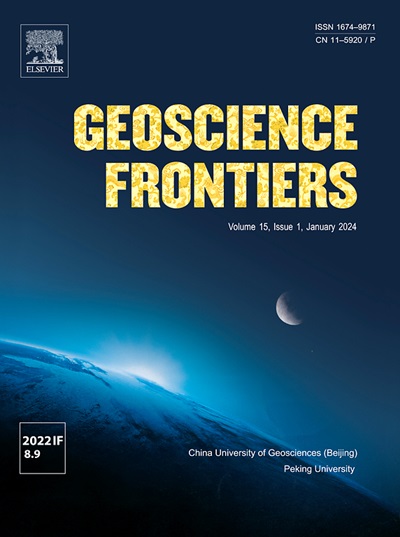全新世至人类世长江三角洲有机碳埋藏
IF 8.9
1区 地球科学
Q1 GEOSCIENCES, MULTIDISCIPLINARY
引用次数: 0
摘要
全新世有机碳(OC)埋藏在大三角洲被认为在调节长期大气二氧化碳水平方面发挥了关键作用,但这一作用可能已被人类世期间的人类活动显著改变。缺乏对全新世三角洲OC埋藏速率的精确估计,阻碍了对碳循环演化的全面理解。本文利用50个全新世钻孔资料和216个现代表层沉积物样本,分析了长江三角洲中全新世至人类世OC来源的变化及其控制因素,并对OC埋藏率进行了定量分析。结果揭示了古岩埋藏演化的三个不同阶段。从8 ~ 2 ka,东亚夏季风的减弱减少了陆地OC的贡献,但YD保持了缓慢的进积和稳定的OC埋藏速率(~ 0.79 Mt/yr)。2 ka后,人类活动成为主要驱动因素,导致OC埋藏率增加78% (1.40 - 1.44 Mt/yr)。三峡大坝蓄水后,黄土高原进入侵蚀破坏阶段,土壤有机质埋藏率较蓄水前下降59%。考虑到水下三角洲侵蚀,YD已经从净OC埋藏系统转变为净OC来源,为浙闽泥带贡献了~ 0.81 Mt/yr的OC。这些发现强调了沉积物埋藏率在调节大三角洲碳封存中的关键作用,并强调了人类改变的沉积物动力学的全球意义,表明世界范围内的三角洲可能类似地从正碳封存和负碳封存过渡。本文章由计算机程序翻译,如有差异,请以英文原文为准。

Holocene to anthropocene burial of organic carbon in the Yangtze delta
Holocene organic carbon (OC) burial in mega-deltas is considered to have played a crucial role in modulating long-term atmospheric CO2 levels, but this role has likely been significantly altered by human activities during the Anthropocene. The absence of precise estimates for Holocene deltaic OC burial rates hinders a comprehensive understanding of carbon cycle evolution. This study, using data from 50 Holocene boreholes and 216 modern surface sediment samples, examines changes in OC sources and their controlling factors, and quantifies OC burial rates in the Yangtze Delta (YD) from the mid-Holocene to the Anthropocene. The results reveal three distinct stages of OC burial evolution. From 8 ka to 2 ka, the weakening East Asian Summer Monsoon reduced terrestrial OC contributions, but the YD maintained slow progradation and stable OC burial rates (∼0.79 Mt/yr). After 2 ka, human activities emerged as the dominant driver, triggering a 78 % increase in OC burial rates (1.40 – 1.44 Mt/yr). Following the impoundment of the Three Gorges Dam, the YD entered an erosion-driven destruction phase, with OC burial rates declining by 59 % compared to pre-dam levels. Accounting for subaqueous delta erosion, the YD has shifted from a net OC burial system to a net OC source, contributing ∼0.81 Mt/yr of OC to the Zhejiang-Fujian mud belt. These findings underscore the pivotal role of sediment burial rates in regulating OC sequestration in mega-deltas and highlight the global implications of human-altered sediment dynamics, suggesting that deltas worldwide may similarly transition from positive and negative OC sequestration.
求助全文
通过发布文献求助,成功后即可免费获取论文全文。
去求助
来源期刊

Geoscience frontiers
Earth and Planetary Sciences-General Earth and Planetary Sciences
CiteScore
17.80
自引率
3.40%
发文量
147
审稿时长
35 days
期刊介绍:
Geoscience Frontiers (GSF) is the Journal of China University of Geosciences (Beijing) and Peking University. It publishes peer-reviewed research articles and reviews in interdisciplinary fields of Earth and Planetary Sciences. GSF covers various research areas including petrology and geochemistry, lithospheric architecture and mantle dynamics, global tectonics, economic geology and fuel exploration, geophysics, stratigraphy and paleontology, environmental and engineering geology, astrogeology, and the nexus of resources-energy-emissions-climate under Sustainable Development Goals. The journal aims to bridge innovative, provocative, and challenging concepts and models in these fields, providing insights on correlations and evolution.
 求助内容:
求助内容: 应助结果提醒方式:
应助结果提醒方式:


